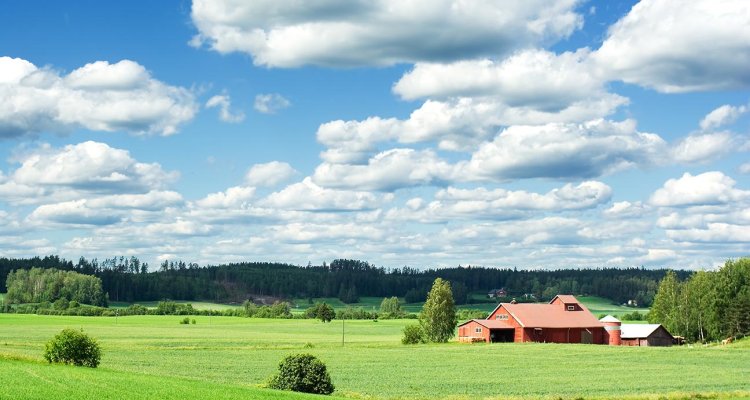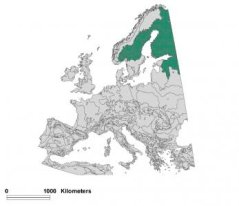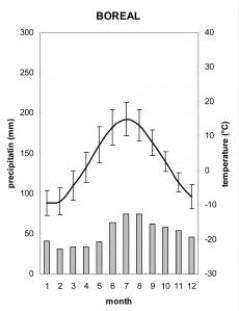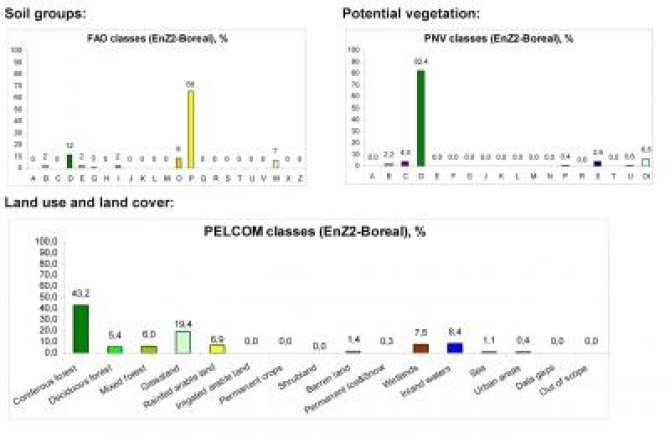
Boreal (BOR)
The environmental zone Boreal occupies low plateaus, undulating plains and lowlands of North-East Europe. The climate is continental. The growing season lasts in average 157 days (126 – 185); the sum of temperatures above +10° is in average 1966° (1471°C to 2523,3 °C). Both values are in the low category.

The same as EnZ ALN, most of the zone was an arena of Quaternary glacial abrasion, as revealed by roches moutonnées and other types of ice-moulded surfaces in Scandinavia, Finland and Karelia.
In the north it covers the outcrops of folded basement of Achaean origin in the east and of Karelian origin in the west. The west of the western segment is within Caledonian folded structures. The geological formations are mostly Pre-Cambrian, except the western periphery of the western segment underlaid by Cambrian-Silurian rocks. Acidic and intermediate Pre-Cambrian intrusions are widespread throughout the whole class, in particular in the west. Basic Pre-Cambrian intrusions are present in the north. The Quaternary formation contains moraines of Salpausselkä stage and, in particular in depressions and big valleys, fluvioglacial, lacustrine, and lacustrine-glacial deposits. Norrland, Manselkä, and Kola are dominated by plains and low mountains. Widespread forms of glacial abrasion (roches moutonnées) remind of the last glaciation. Altitudes vary from the sea level to 500-1000 m in Manselkä and pediments of the Scandinavians

Central Finland covers tectonic structures of Baltic shield represented by the outcrops of folded basements mostly of Achaean age in the north and east, and of Karelian age in the south. The geological formations are mostly Middle Pre-Cambrian in the north-west and west, and Lower Pre-Cambrian in the east. Pre-Cambrian acidic and intermediate intrusions are widespread, in particular in the south-west; basic intrusions of the same age are present, though less common
More to the south the dominating geological formations are acidic and intermediate Pre-Cambrian intrusions in the west and Middle and Lower Pre-Cambrian rocks in the east. The small massifs of Pre-Cambrian basic intrusions are present everywhere in the class. Here the lake covered plains of Finland are found.
The most southern part of the Boreal zone around St Petersburg lies on the mantle of the ancient Russian platform. The depth of the surface of crystalline basement varies from 0 m in the west to over 1500 m in the east. It covers the outcrops of the Baltic Shield. They are mostly Karelian structures; in the central part of the class they are mixed with Achaean structures. The dominating rocks are Pre-Cambrian. Ancient intrusions are widespread: acidic and intermediate Pre-Cambrian in the east, and intermediate Pre-Cambrian and intermediate and alkalic Palaeozoic in the west. The dominating Quaternary sediments are moraines. Numerous depressions are often filled in by lacustrine and lacustrine-glacial deposits.
The most typical habitat is taiga composed by evergreen coniferous trees. Bogs are very common. The agricultural lands are dominated by grasslands. The main crop is barley; the North of the region is used mainly for forestry and grazing.
